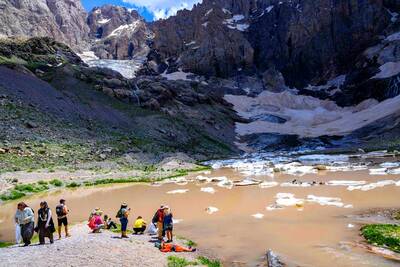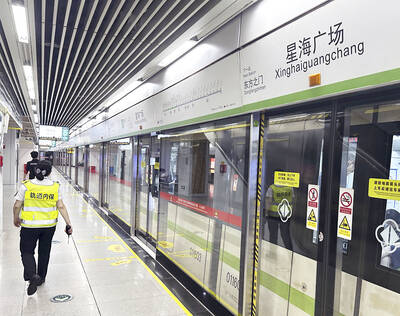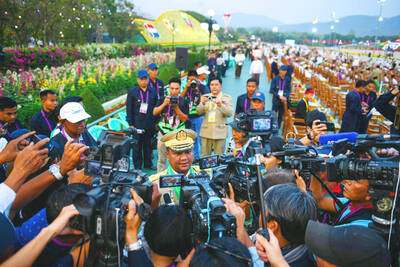Two years ago, molecular biologist Shi Yigong (施一公) was a prize-winning Princeton University professor with annual research funding of more than US$2 million and a seemingly limitless US academic career.
However, Shi did exactly what China’s leadership hopes to see more of — he turned his back on all that to return to his homeland after two decades abroad.
The recent return of people like Shi, who now heads the life sciences department at Tsinghua University in Beijing, has provided a ray of hope for China in its uphill battle to reverse a long-term “brain drain” of top experts.
“China has contributed disproportionately to the advancement of science and technology in the United States, for example,” Shi said of the steady stream of China’s best and brightest who left for greener pastures in decades past. “Behind China’s shiny glass skyscrapers, it has an extreme shortage of top talents and that is really regrettable.”
With aspirations of becoming a science and technology power, China has tried for years to halt an exodus of top minds, a lingering legacy of the 1966-1976 Cultural Revolution when campus upheavals closed universities for years.
The chaos severely set back Chinese science and academia. Afterwards, many students — with official encouragement — opted for study abroad, where most have stayed. Many took foreign citizenship.
Shi, 43, said China’s growing clout and rapidly modernizing research institutions make it an increasing draw for returning academics, known here as “sea turtles” swimming back to their home beaches.
“For talented people to apply their talents, the sky is the limit now in China in terms of innovation,” Shi told reporters after a tour of a lab where he studies cell proteins, with possible implications for cancer drug development.
The “sea turtle” response, however, has been weak so far.
From 1978 through last year, 1.62 million Chinese went abroad for graduate studies, according to the government. Only 460,000 have returned. Last year 229,000 left, up 27.5 percent from 2008.
However, returnees leapt 56 percent to 108,000 last year, many drawn by increasingly lucrative enticements and growing research funding.
One current program offers recruits a basic 1 million yuan (US$147,000) in government funds — plus additional money from their employers and other sources. The government this year promised even more attractive policies.
The issue resonates in China. Nationalist pioneer Sun Yat-sen (孫逸仙) and later revolutionaries like former Chinese leader Deng Xiaoping (鄧小平) and former Chinese premier Zhou Enlai (周恩來), among other notables, were educated or radicalized abroad before returning to shake the halls of power.
Yet experts say continued academic problems repel potential returnees. They include rampant research plagiarism, a lack of political autonomy at universities and a sclerotic academic system marked by infighting and an overemphasis on connections, which stifles innovation.
“You have a large number of incompetent scientists that get lots of funding because they work the system,” said Rao Yi (饒毅), who returned in 2007 from a top research position at Northwestern University to head the life sciences department at Peking University.
“Sea turtles” also encounter resistance from their Chinese peers, who view them as overpaid interlopers, Shi said.
Rao, who is renouncing his US citizenship to retake a Chinese passport, said patriotism was only a small factor in his return.
“It’s more a question of what side of history you want to be on,” he said, noting China’s rise.
However, it will be decades until China rivals the West in innovation, he added.
“If you look at the curve, in 20 years we could be doing pretty well. But if we don’t solve some of the structural problems, maybe we won’t go very high, but rather get stuck somewhere in the middle,” Rao said.

In the sweltering streets of Jakarta, buskers carry towering, hollow puppets and pass around a bucket for donations. Now, they fear becoming outlaws. City authorities said they would crack down on use of the sacred ondel-ondel puppets, which can stand as tall as a truck, and they are drafting legislation to remove what they view as a street nuisance. Performances featuring the puppets — originally used by Jakarta’s Betawi people to ward off evil spirits — would be allowed only at set events. The ban could leave many ondel-ondel buskers in Jakarta jobless. “I am confused and anxious. I fear getting raided or even

Kemal Ozdemir looked up at the bare peaks of Mount Cilo in Turkey’s Kurdish majority southeast. “There were glaciers 10 years ago,” he recalled under a cloudless sky. A mountain guide for 15 years, Ozdemir then turned toward the torrent carrying dozens of blocks of ice below a slope covered with grass and rocks — a sign of glacier loss being exacerbated by global warming. “You can see that there are quite a few pieces of glacier in the water right now ... the reason why the waterfalls flow lushly actually shows us how fast the ice is melting,” he said.

RISING RACISM: A Japanese group called on China to assure safety in the country, while the Chinese embassy in Tokyo urged action against a ‘surge in xenophobia’ A Japanese woman living in China was attacked and injured by a man in a subway station in Suzhou, China, Japanese media said, hours after two Chinese men were seriously injured in violence in Tokyo. The attacks on Thursday raised concern about xenophobic sentiment in China and Japan that have been blamed for assaults in both countries. It was the third attack involving Japanese living in China since last year. In the two previous cases in China, Chinese authorities have insisted they were isolated incidents. Japanese broadcaster NHK did not identify the woman injured in Suzhou by name, but, citing the Japanese

RESTRUCTURE: Myanmar’s military has ended emergency rule and announced plans for elections in December, but critics said the move aims to entrench junta control Myanmar’s military government announced on Thursday that it was ending the state of emergency declared after it seized power in 2021 and would restructure administrative bodies to prepare for the new election at the end of the year. However, the polls planned for an unspecified date in December face serious obstacles, including a civil war raging over most of the country and pledges by opponents of the military rule to derail the election because they believe it can be neither free nor fair. Under the restructuring, Myanmar’s junta chief Min Aung Hlaing is giving up two posts, but would stay at the